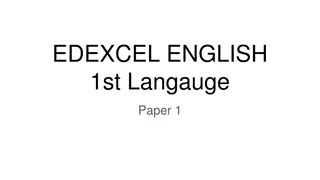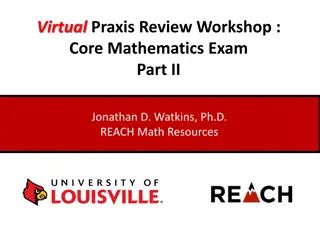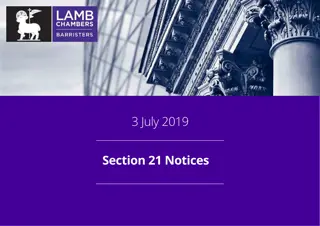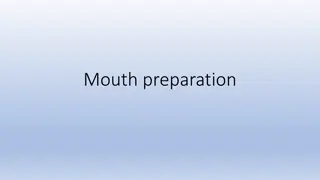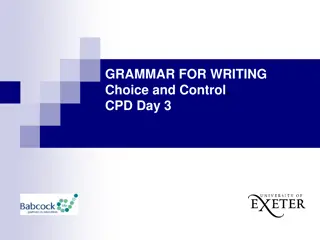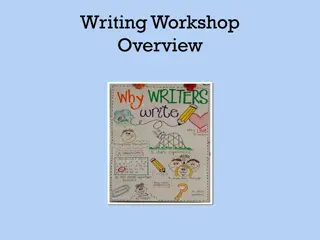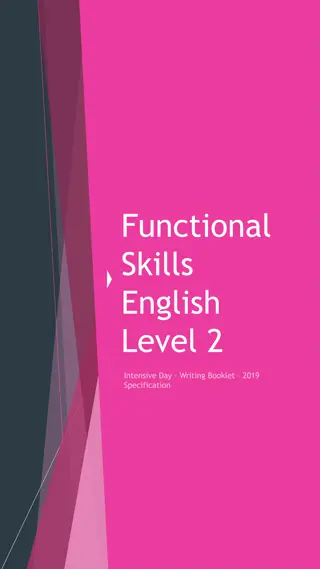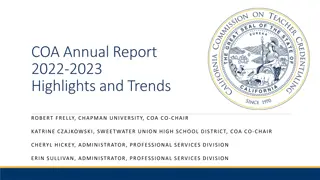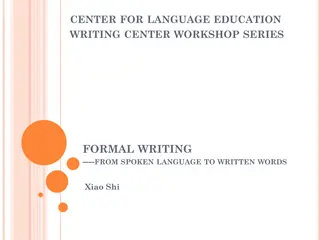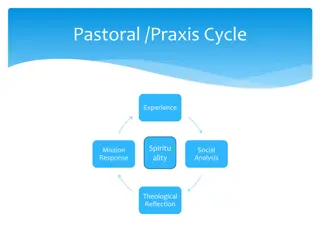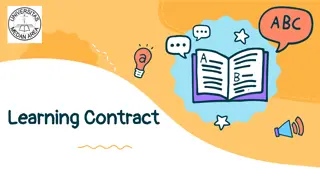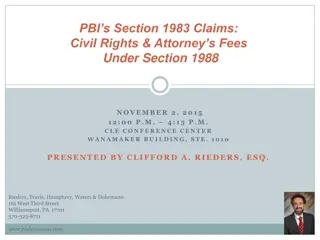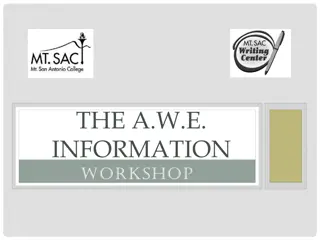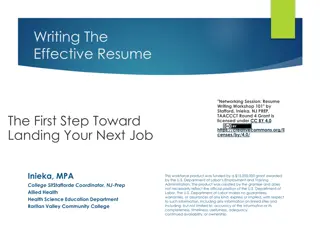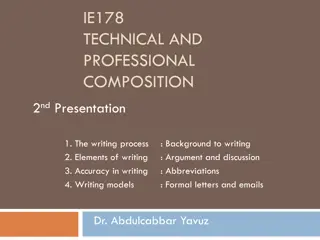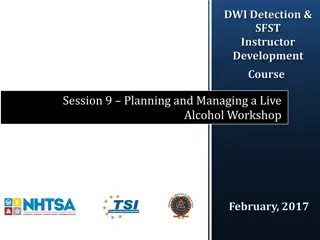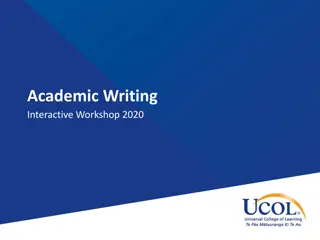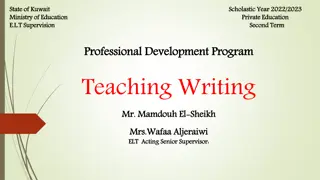Comprehensive Praxis Preparation Workshop for Writing Section
Engage in a comprehensive Praxis preparation workshop focusing on the writing section. Share study tips, set goals, and practice writing essays under timed conditions. Utilize the Writing Center for guidance on essay features, strategies, and feedback. Tailor your approach, improve timing, and enhance content strategies with targeted practice sessions. Understand the components of the selected response section and refine skills in usage, sentence correction, revision, and research.
Download Presentation

Please find below an Image/Link to download the presentation.
The content on the website is provided AS IS for your information and personal use only. It may not be sold, licensed, or shared on other websites without obtaining consent from the author. Download presentation by click this link. If you encounter any issues during the download, it is possible that the publisher has removed the file from their server.
E N D
Presentation Transcript
Praxis 1: CORE Writing Subtitle
Warm-Up What is everyone s general plan for Praxis prep? What study tips do you have for other folks in the meeting? What are you all hoping to get from today s workshop? This is also a learning process for us, so please feel free to share questions, experiences, successes, and frustrations about the Praxis process, writing, etc. at any point!
You should come to the Writing Center. Make an appointment now. Right now. While I m talking. www.writing.louisville.edu The most important thing that I will say today is that this workshop is not going to go into enough detail about all of the features that the essays require. There really is no substitute for experience. So I highly suggest: 1 Find a set of practice questions for the essays 2. Write a practice essay in the 30 minute time frame like it s the real thing 3. Make an appointment at the Writing Center 4. Bring the prompt and the essay (we ll have the rubric) to the Writing Center to talk over how it went, strategies for approaching different kinds of questions, and general questions about grammar, usage, etc. 5. Repeat steps 1-3. 6/. Repeat step 4.
Take a targeted approach that picks one goal to work on. Use a session to focus on the timing how long to outline, how long to leave yourself to proofread the material. Use sessions to practice various content strategies (making sources agree/disagree, pushing back against sources, storytelling-to- assertion practice, getting philosophical, etc.). Bring in two short sample sources and read them over with a consultant and brainstorm how to bring them together to create an essay.
The Question part of the test has four parts 1. Usage 2. Sentence Correction 3. Revision in Context 4. Research Skills
Usage Sentence Mechanics Sentence Structure and Grammatical Relationships Expressions and Word Choice Some questions ask about errors, others ask you to determine sentences with no usage issues.
Sentence Correction You ll be asked to identify which of the multiple choice answers is the best way to restate the provided sentence. Be careful, though. Sometimes the original sentence will be the best of the options.
Revision in Context A section of writing is provided and then you ll be asked multiple choice questions about ways the passage can be improved in a number of ways: Grammar or Style Errors Ideal order of the sentences provided. Transitions Combining Sentences Adding or Removing information based on relevance. Selecting the sentence that contains no grammar or style errors and best concludes the passage.
Strategies There s a bit of a debate about how to approach questions in this section. Some have suggested reading the questions so that you know what to look out for when reading. Others, however, say that takes too long and you end up getting all twisted up. The questions tend to come in chronological order relative to the passage.
Research Skills Identifying the right research strategy for particular research tasks. Citation practices and formatting Identifying relevant information for a research task Assessing source credibility.
Tips Practice speed reading, or actively speeding up your pace for reading with comprehension. Try to get a test mode structure where you have various pacing strategies and memory strategies to help you sustain focus and pace throughout the exam time. Work on time management complete the easy questions first, and then work your way back to the more difficult ones. A few people have noted that there are sometimes redundancy errors that really trip them up. The example I saw the person noted that a sample test marked People protested against the war as an incorrect sentence because it was redundant (that seems wild to me, but it was a useful example).
Resources The ETS and Kahn Academy have collaborated to produce a set of free study materials: Lessons | Praxis Core Writing | Test prep | Khan Academy https://praxis.ets.org/ Core Academic Skills for Educators: Writing (ets.org)
Two Essays, 30 minutes each The argumentative essay asks that you read an assertion and then construct a well-considered response that makes the case for a focused point. The source-based essay asks that you read two short sources and then identify the key concerns that they articulate and then successfully summarize, synthesize, and cite the materials.
What they ECS says it is looking for: 1. Address the assigned task appropriately for an audience of educated adults or very intelligent cats. 2. Organize and develop ideas logically, making coherent connections between them. 3. Provide and sustain a clear focus or thesis 4. Use supporting reasons, examples, and details to develop clearly and logically the ideas presented. 5. Demonstrate facility in the use of language and the ability to use a variety of sentence structures. 6. Construct effective sentences that are generally free of errors in standard written English. 7. I added the cat thing.
6 5 4 3 2 1 Thesis States or clearly implies the writer s position or thesis States or clearly implies the writer s position or thesis States or Implies the writer s position or thesis Limited in stating or implying a position or thesis No clear position or thesis Is incoherent Organ- ization Organizes and develops ideas logically,making insightful connections between them Organizes and develops ideas clearly, making connections between them Shows control in the organization and development of ideas Limited control in the organization and development of ideas Weak organization or very little development Is undeveloped Support of Ideas/ Argument Clearly explains key ideas, supporting them with well-chosen reasons, examples or details Explains key ideas, supporting them with relevant reasons, examples, and details Explains some key ideas, supporting them with adequate reasons, examples, or details Inadequate reasons, examples, or details to explain key ideas Few or no relevant reasons, examples, or details Contains serious and persistent writing errors Sentence Variety Displays effective sentence variety Displays some sentence variety Displayslittle sentence variety N/A N/A Language Choice Clearly displays facility in the use of language Displays facility in the use of language Displays adequate use of language An accumulation of errors in the use of language Frequent serious error in the use of language Grammar, Usage, Mechanics Is generally free from errors in grammar usage and mechanics Is generally free from errors in grammar, usage, and mechanics Shows control of grammar, usage, and mechanics, but may display errors An accumulation of errors in grammar, usage, and mechanics Frequent serious errors in grammar, usage, and mechanics.
Looking at the Examples provided by ECS, some common moves made in the essay include: Making very clear statements of agreement or disagreement, but with thoughtful structure Agree, and explain the reasons why or extend the argument further Agree in general, but disagree with certain parts Disagree, and explain the reasons for the disagreement Disagree in general, but point out that the statement does have some good points. Providing representative anecdotes Short stories personal or general that allow the writer to make a point
Organization Write at least three paragraphs, aim for five paragraphs (but this can be hard in 30 minutes) Each paragraph should be made up of a coherent point and some kind of support. Then consider how the smaller points can be connected to pattern the larger response.
Language and Sentence Variety Pick your battles. From examples, writers who receive 6 for this category don t use one complicated word after another. Instead, they drop one or two of those SAT words per paragraph. Sentence variety Avoid writing every sentence with just a subject, verb, predicate structure without any attempt to combine sentences or add various in-sentence additions like: Connecting transitions Non-restrictive information additions
What they seem to be looking for A clear statement of the main concerns related to the topic A writer s ability to select important information that supports the work of their essay. A writer s ability to synthesize information from two sources A writer who is able to make decisions about when and how to paraphrase and/or quote A writer who knows their way around citation practices.
6 5 4 3 2 1 Insightfully explains why the concerns are important, supporting the explanation with effective links between the two sources and well-chosen reasons, examples, or details Clearly explains why the concerns are important, supporting the explanation with clear links between the two sources and relevant reasons, examples, or details Adequately explains why the concerns are important, supporting the explanation with some links between the two sources and adequate reasons, examples, or details. Limited in explaining why concerns are important Concerns Incorporates information from both sources to identify and explain important concerns regarding the issue discussed in the sources Incorporates information from both sources to identify and explain important concerns regarding the issue discussed in the sources. Incorporates only once source to identify and explain concerns or incorporates two sources inadequately Incorporates only once source to identify and explain concerns or incorporates two sources inadequately Info Incorpora tion Organizes and develops ideas logically Organizes and develops ideas clearly Limited in supporting the explanation (establishes only a weak link between sources and/or offers inadequate reasons, examples, or details) Limited in supporting the explanation (establishes only a weak link between sources and/or offers inadequate reasons, examples, or details) Organizat ion Displays effective sentence variety Displays some sentence variety accumulation of errors in the use of language accumulation of errors in the use of language Sentence Variety Is generally free from errors in grammar, usage, and mechanics An accumulation of errors in grammar, usage, and mechanics An accumulation of errors in grammar, usage, and mechanics Grammar Displays facility in the use of language Language Cites both sources when paraphrasing or quoting Is generally free from errors in grammar, usage, and mechanics Cites sources when paraphrasing or quoting. Cites sources when paraphrasing or quoting. Citation
Lets Discuss What concerns you most about this section of the exam?
Lets Strategize Prompt: Directions: The following assignment requires you to use information from two sources to discuss concerns that relate to a specific issue. When paraphrasing or quoting from the two sources, cite each source used by referring to the author s last name, the title, or any other clear identifier. Assignment: Automatic teller machines (sometimes called ATMs or ATM machines) allow people to withdraw cash from their bank accounts remotely. ATM users insert their bank cards into the machine and request cash. The ATM then dispenses the cash and makes an electronic withdrawal from the user s bank account. In this transaction, additional money is also drawn from the ATM user s bank account in the form of ATM service fees. Both of the following sources address the relationship that ATM use has with bank accounting, and particularly whether ATM fees place an unfair financial burden on the people who use them. Read the two passages carefully and then write an essay in which you identify the most important concerns regarding the issue and explain why they are important. Your essay must draw on information from BOTH of the sources. In addition, you may draw on your own experiences, observations, or readings. Be sure to CITE the sources whether you are paraphrasing or directly quoting.
Source #1 Adapted from: Nym, Alex. Legal Theft: How Financial Service Fees Inhibit Capitalism. Madison, Wisconsin: Vanity Press. 2015. 81-82. Web. 13 Jun. 2016. It seems incredibly unfair to have to pay money just to access your own money. Unfortunately, this form of highway robbery happens millions of times every day at ATMs across the nation. What makes ATM fees the most frustrating is their unpredictable costs. The costs themselves can vary widely. One ATM may have charge cardholders three or four times as much as another ATM. While these variations might theoretically create healthy competition among different privately owned ATM stations, in reality, consumers don t have the time to explore every ATM in an area and find the best deal. It seems that the ATM s particular brand of legal theft is on the rise. Since ATM owners first began charging the bank account holders who use their machines, prices for ATM use have risen astronomically. To make matters worse, the actual bank that issues the bank card will often charge an additional fee to its hapless cardholders. This means that when someone uses an ATM to withdraw money from their bank account, they are not just charged a fee by the owner of the ATM. They pay a fee to the bank where they have their account. With this double charge, a small twenty dollar ATM withdrawal can have an additional cost of ten dollars, and sometimes more. Aside from being unethical, ATM user fees are also financially harmful to consumers and to businesses. High ATM fees discourage people from spending money, and this means lower sales volumes at stores, restaurants, and other establishments.
Source #2 Adapted from: Eincer, Brenda. Un-Nickeled and Un-Dimed: Financial Health for Individuals and Industry. Boston: Nosredna Publishing. 2014. 81-82. Web. 31 Mar. 2015. People are quick to complain about the fees they pay at the ATM. But these fees are a small price to pay for the benefits of ATMs. These machines are helpful to both consumers and businesses. Withdrawing money from an ATM has many advantages in spite of the potential fees. It s easy to forget that any use of money from a bank account comes at a cost. Alternatives to ATM cash withdrawal also cost money, in the form of fees for payments made with cards, interest paid on credit card purchases, fees for writing checks, and so on. And bear in mind, those bank fees only are just the ones that impose costs on individual consumers. When people pay with a card, merchants themselves pay additional costs, in the form of merchant service fees. Merchant service fees are fees that sellers have to pay to the bank in order to process bank card transactions. These fees for receiving non-cash payments can be a real burden to business owners, but are avoidable when the customer pays in cash. Ultimately, ATMs may actually help customers and businesses save money. Some claim that ATM fees have greatly increased in the last few decades, but this statement is only partly accurate. Yes, average fees have risen at ATMs that charge fees. However, there is a growing trend of no-fee ATMs. Increasingly, restaurants, stores, and other retail businesses are purchasing their own ATMs and offering cash withdrawals without fees to their customers. This practice allows businesses to reduce the merchant service fees they pay because their customers pay in cash. This is a win for consumers as well, as they are able to minimize ATM fees by patronizing certain establishments.
Paragraph #1 ATM fees, the fees people pay to access cash from their bank accounts via automated teller machine, raise a number of socioeconomic issues due to their increasingly high costs. In his essay, Alex Nym complains of the unfair nature and unpredictable costs that people face when they want to access their personal funds through an ATM ( Legal Theft: How Financial Services Inhibit Capitalism ). Nym claims that average fees for ATM use have risen a great deal in the last 30 years. He also notes that many customers get double-charged when they use an ATM; first, the owner of the ATM charges a fee for ATM use. Then, the bank where the money is withdrawn from charges an additional fee for removing the cash from the account. Nym suggests that ATM fees are bad for the economy as a whole because they discourage people from taking out money and spending it.
Brenda Eincer, author of the book Un-Nickeled and Un-Dimed: Financial Health for Individuals and Industry, has a perspective that runs counter to Nym s. Eincer feels that ATM fees are not unreasonable, and the people get many benefits in exchange for the cost of ATM use. Challenging Nym s assumption that ATM use raises costs, Eincer points out that that there are also service fees for alternatives to ATM cash withdrawal. She asserts that using a debit or credit card or writing a check also have costs. This author also brings up the issue of the merchant service fees that businesses need to pay when they receive payments by card instead of by cash from an ATM. In Eincer s opinion, ATM fees may be the better deal for both ATM users and the businesses where they shop. Finally, Eincer offers a different perspective than Nym s with regards to rising ATM fees. She notes that while some ATMs charge more than before, many businesses now host no-fee ATMs to encourage onsite shopping.
Paragraph #3 Both authors agree that ATM use certainly has noticeable costs and that the highest ATM fees are higher than ever. The real debate is whether these costs are worth it. Nym and others who share his views would argue that the costs of ATM use have risen too high and ultimately discourage economic activity. On Eincer s side of the debate, it seems possible that ATM costs are potentially cheaper than those associated with card and checkbook purchases. If that proves to be the case, then ATM use may actually benefit both shoppers and businesses.
Thank You! writing@louisville.edu


